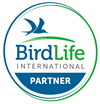Birds live in a wide variety of habitats in Hong Kong. There are mountains up to nearly 1,000 meters in height, wetlands, woodlands, open country, coastal areas, and of course, cities and villages.
Wetlands
Both freshwater and brackish water wetlands can be found in Hong Kong.
Brackish water wetlands form when streams flow into the sea, creating an area of high salinity around estuaries as water flow becomes slower. This encourages the accumulation of sediment which provides a rich substrate for the growth of mangrove and reed. The Pearl River Delta lies to the northwest of Hong Kong, and the largest brackish wetland is found here. About 15 km2 of the Mai Po Inner Deep Bay wetlands was designated as a Ramsar Site in September 1995. During winter, spring and autumn, it hosts tens of thousands of waterbirds and waders, as well as the species that prey on them.
Freshwater wetlands, including fishponds and farmland, are located in the northwest New Territories. Fishponds are drained in winter as part of the fishpond management. This concentrates the ‘trash fish’ in the small pools that are left behind, drawing dozens of egrets to feed. The muddy fishpond bottom also attracts good numbers of waders.Some farmers pump water from underground to create a type of freshwater wetland, which is usually located in the flood plains. Long Valley, near Sheung Shui, which is also regarded as a cultural heritage site, is the largest remaining area of freshwater wetland where water spinach and watercress are cultivated. The place attracts many pipits, rails, wagtails, Zitting Cisticolas, Greater Painted-snipes, shrikes and starlings.
Streams
There are no large rivers in Hong Kong. Shing Mun River and Kam Tin River are in fact concreted ditches which were built to channel water flow. Natural streams are found mainly in country parks. Well-known places with this kind of habitat include Tai Po Kau Nature Reserve, Shing Mun Reservoir, Ng Tung Chai, Nam Chung and Tai Ho River. Streams often pass through many different habitats, such as woodland and wetland. They provide habitats for insects, and at the same time good feeding habitats for herons, wagtails, kingfishers and flycatchers.
Ocean, Coastal Area and Islands
Hong Kong has various types of coastal habitats, including rocky shores, sandy shores, mudflats, cliffs and small islands. In addition to certain waterbirds and Pacific Reef Egrets, White-bellied Sea Eagles also breed in these areas. They also breed in some small ininhabited islands in eastern waters during summer. During the migration season, and particularly if typhoons occur, there are good chances for seeing rare seabirds, such as boobies, petrels and jaegers, which can be blown inshore.
Open Country
Open country is any open area with vegetation, limited trees, and no human settlements. These include shrubland, grassland and abandoned farmland. Some lowland areas are also flooded and have become overgrown with grasses. These habitats can be easily found in Hong Kong. On the fringe of woodland areas these habitats harbour cuckoos, coucals, and buntings. In the evening, it is worth listening for the calls of nightjars and owls. Locations with extensive open country in Hong Kong include Tsim Bei Tsui, San Tin, Lok Ma Chau, Kam Tin, Tung Tze, Luk Keng, and Yung Shue O.
Woodland
In the early 19th century, Hong Kong Island was famously described as “a barren rock, without a tree upon it”. At that time, most woodland was found in small fung shui patches behind villages. Nowadays, most of the vegetation cover is secondary woodland, which has regenerated since the end of the Second World War . Most woodland is located within country parks, which provide a high degree of protection against development. These areas, with lower human disturbance, have gradually become more mature and attract species which favour forest habitat including barbets, minivets, cuckoo-shrikes, bulbuls, warblers, tits, sunbirds, thrushes and flowerpeckers. Well-known woodlands good for bird watching include Tai Po Kau Nature Reserve, Shing Mun Reservoir, Kap Lung, Lung Fu Shan, and the Tai Tam Reservoir area.
High Ground
The slopes of some high hills retain little water. Here the only vegetation is often shrubs and ferns. These are the best places for raptors, including eagles, buzzards, and falcons. There is a good chance of spotting Chinese Francolin and at higher altitudes Large Grass Warblers and Upland Pipits. Examples of these areas are Tai Mo Shan and Fei Ngo Shan.
Urban Areas
The urban areas of Hong Kong are concentrated on flat land along the coast. A number of bird species have adapted to the urban environment, which provides them with protection from natural threats such as thunderstorms, strong winds and predators. Trees and shrubs along roadsides and in housing estates are used as roosting areas by various bird species. Overhanging building features are used as nesting areas by swallows and swifts. Parks are also a good feeding and roosting area for a number of species such as Tree Sparrows, Crested Mynas and Magpies which choose to breed in urban areas.



